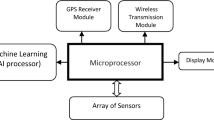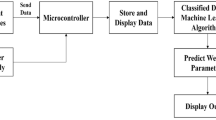Abstract
IoT networks have become famous and utilized in many industries such as agriculture, medical, manufacture, and others due to their efficiency and productivity. WSN is an IoT network used for smart farming and smart health monitoring. WSNs can self-manage, self-configure, self-diagnose, and self-heal, making them ideal for agricultural monitoring. A wireless sensor network collects data from numerous sensor nodes scattered across the physical world. WSN data processing is critical when a node fails for unknown reasons. Data handling is an essential aspect of WSN; once any node fails due to unknown reasons, data reliability and availability become crucial. Hence, limited battery energy, low bandwidth, limited computing capacity, and link failure affect network performance. Therefore, an effective cluster-based data aggregation with an appropriate routing must be designed in the media access control. The proposed hybrid artificial neural network and decision tree algorithm with cognitive radio is developed to select the cluster head. The higher amount of residual energy increases the number of packets received at the base station and aggregate the data from the normal sensor nodes. The on-demand routing protocol is designed to keep data in local storage for retransmission during link failure to obtain reliable data transmission. The proposed method performance is analyzed as residual energy, end to end delay, normalized overhead, packet delivery ratio, packet drop, and throughput. This proposed method is evaluated with the cluster-based data aggregation scheme to prove its efficiency. The proposed method residual energy is 8.3Joules for 50 nodes; it is high compared to the cluster-based data aggregation scheme.
















Similar content being viewed by others
References
Abbasi-Daresari S, Abouei J (2016) Toward cluster-based weighted compressive data aggregation in wireless sensor networks. Ad Hoc Netw 36:368–385
Alami HE, Najid A (2019) ECH: An enhanced clustering hierarchy approach to maximize lifetime of wireless sensor networks. IEEE Access 7:107142–107153
Ali AB, Tabassum M, Mathew K (2016) A comparative study of IGP and EGP routing protocols, performance evaluation along load balancing and redundancy across different AS. In: Proceedings of the International Multi Conference of Engineers and Computer Scientists, vol 2, pp 487–967
Azharuddin M, Jana PK (2017) PSO-based approach for energy-efficient and energy-balanced routing and clustering in wireless sensor networks. Soft Comput 21(22):6825–6839
Chakraborty C, Gupta B, Ghosh SK (2013) A review on telemedicine-based WBAN framework for patient monitoring, int. journal of telemedicine and e-Health. Mary Ann Libert Inc 19(8):619–626. https://doi.org/10.1089/tmj.2012.0215
Chakraborty C, Roy R, Pathak S, Chakrabarti S (2011) An optimal probabilistic traffic engineering scheme for heterogeneous networks. CIIT Int J Fuzzy Syst 3(2):35–39. FS022011003, Print: ISSN 0974–9721 & Online: ISSN 0974–9608.
Daneshvar SMH, Mohajer PAA, Mazinani SM (2019) Energy-efficient routing in WSN: A centralized cluster-based approach via grey wolf optimizer. IEEE Access 7:170019–170031
Devi VS, Ravi T, Priya SB (2020) Cluster based data aggregation scheme for latency and packet loss reduction inWSN. Comput Commun 149:36–43
Elsmany EFA, Omar MA, Wan TC, Altahir AA (2019) EESRA: Energy efficient scalable routing algorithm for wireless sensor networks. IEEE Access 7:96974–96983
Gupta SK, Jana PK (2015) Energy efficient clustering and routing algorithms for wireless sensor networks: GA based approach. Wirel Pers Commun 83(3):2403–2423
Hidoussi F, Toral-Cruz H, Boubiche DE, Martínez-Peláez R, Velarde-Alvarado P, Barbosa R, Chan F (2017) Power efficient and adaptive latency hierarchical routing protocol for cluster-based WSN. Wireless Pers Commun 96(4):4929–4945
Kamalesh S, Ganesh Kumar P (2017) Data aggregation in wireless sensor network using SVM-based failure detection and loss recovery. J Exp Erim Ental Theor Artif Intell 29(1):133–147
Mantri DS, Prasad NR, Prasad R (2015) Bandwidth efficient cluster-based data aggregation for wireless sensor. Netw Comput Electr Eng 41:256–264
Mantri DS, Prasad NR, Prasad R (2016) Mobility and heterogeneity aware cluster-based data aggregation for wireless sensor network. Wireless Pers Commun 86(2):975–993
Mishra S, Sagban R, Yakoob A, Gandhi N (2018) Swarm intelligence in anomaly detection systems: an overview. Int J Comput Appl 3(2):1–10
Mohanasundaram R, Periasamy PS (2015) Clustering based optimal data storage strategy using hybrid swarm intelligence in WSN. Wirel Pers Commun 85(3):1381–1397
Nayak P, Devulapalli A (2015) A fuzzy logic-based clustering algorithm for WSN to extend the network lifetime. IEEE Sens J 16(1):137–144
Qian H, Fu P, Li B, Liu J, Yuan X (2018) A novel loss recovery and tracking scheme for maneuvering target in hybrid WSNs. Sensors 18(2):341
Rahul M, Kohli N, Agarwal R, Mishra S (2019) Facial expression recognition using geometric features and modified hidden Markov model. Int J Grid Util Comput 10(5):488–496
Sharma T, Tabassum M (2021) Enhanced algorithm to optimize QoS and security parameters in Ad hoc networks. design methodologies and tools for 5G network development and application. IGI Global, pp 1–27
Srividhya V, Shankar T (2018) Energy proficient clustering technique for lifetime enhancement of cognitive radio–based heterogeneous wireless sensor network. Int J Distrib Sens Netw 14(3):1550147718767598
Sun Z, Tao R, **ong N, Pan X (2018) CS-PLM: Compressive sensing data gathering algorithm based on packet loss matching in sensor networks. Wirel Commun Mob Comput 2018:1–2. https://doi.org/10.1155/2018/51319492018
Sundresan P, Mujahid T, Ganthan N, Suresh P, Chinmay C, Saju M, Zeeshan B, Mohammad TQ (2021) ANN based novel approach to detect node failure in wireless sensor network. CMC-Comput Mater Continua 69(2):1447–1462
Suresh P, Saravanakumar U, Iwendi C, Mohan S, Srivastava G (2021) Field-programmable gate arrays in a low power vision system. Comput Electr Eng 90:106996
Tabassum M, Mathew K (2014) A genetic algorithm analysis towards optimization solutions. Int J Digit Inform Wirel Commun 4(1):124–143
Tabassum M, Zen K (2014) Signal interference evaluation of Eko wireless sensor network. In: 19th International Conference on Transformative Research in Science and Engineering, Business and Social Innovation (SDPS 2014)
Tabassum M, Zen K (2017) Evaluation and improvement of data availability in WSNs cluster base routing protocol. J Telecommun Electron Comput Eng (JTEC) 9(2–9):111–116
Tabassum M, Perumal S, Mohanan S, Suresh P, Cheriyan S, Hassan W (2021) IoT, IR 4.0, and AI technology usability and future trend demands: Multi-criteria decision-making for technology evaluation. Design Methodologies and Tools for 5G Network Development and Application. IGI Global, pp 109–144
Toor AS, Jain AK (2019) Energy aware cluster based Multi-hop Energy Efficient Routing Protocol using Multiple Mobile Nodes (MEACBM) in wireless sensor networks. AEU-Int J Electron Commun 102:41–53
**e WX, Zhang QY, Sun ZM, Zhang F (2015) A clustering routing protocol for WSN based on type-2 fuzzy logic and ant colony optimization. Wireless Pers Commun 84(2):1165–1196
Xu C, **ong Z, Zhao G, Yu S (2019) An energy-efficient region source routing protocol for lifetime maximization in WSN. IEEE Access 7:135277–135289
Yadav RN, Misra R, Saini D (2018) Energy aware cluster based routing protocol over distributed cognitive radio sensor network. Comput Commun 129:54–66
Yue Y, Cao L, Hang B, Luo Z (2018) A swarm intelligence algorithm for routingrecovery strategy in wireless sensor networks with mobile sink. IEEE Access 6:67434-67445
Funding
The authors received no specific funding for this study.
Author information
Authors and Affiliations
Corresponding author
Ethics declarations
The manuscript has not been submitted to more than one journal for simultaneous consideration. The manuscript has not been published previously. The Research not involved human participants and/or animals.
Conflict of interest
The authors declare that they have no conflicts of interest to report regarding the present study.
Additional information
Publisher’s Note
Springer Nature remains neutral with regard to jurisdictional claims in published maps and institutional affiliations.
Rights and permissions
About this article
Cite this article
Tabassum, M., Perumal, S., Kashem, S.B.A. et al. Enhance data availability and network consistency using artificial neural network for IoT. Multimed Tools Appl 83, 3111–3131 (2024). https://doi.org/10.1007/s11042-022-13337-6
Received:
Revised:
Accepted:
Published:
Issue Date:
DOI: https://doi.org/10.1007/s11042-022-13337-6




